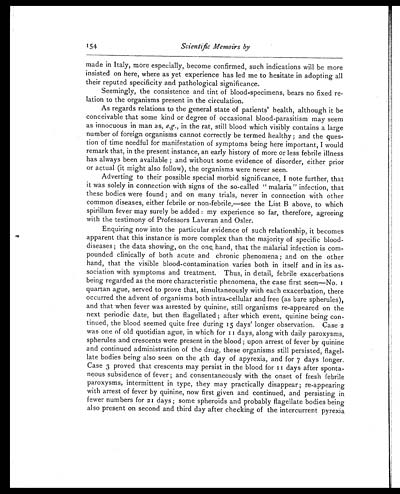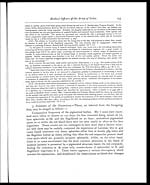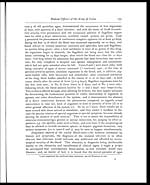Medicine - Institutions > Army health reports and medical documents > Scientific memoirs by medical officers of the Army of India > Part III, 1887 > 10 - Note on some aspects and relations of the blood-organisms in ague
(160) Page 154
Download files
Individual page:
Thumbnail gallery: Grid view | List view

154
Scientific Memoirs by
made in Italy, more especially, become confirmed, such indications will be more
insisted on here, where as yet experience has led me to hesitate in adopting all
their reputed specificity and pathological significance.
Seemingly, the consistence and tint of blood-specimens, bears no fixed re-
lation to the organisms present in the circulation.
As regards relations to the general state of patients’ health, although it be
conceivable that some kind or degree of occasional blood-parasitism may seem
as innocuous in man as, e.g., in the rat, still blood which visibly contains a large
number of foreign organisms cannot correctly be termed healthy; and the ques-
tion of time needful for manifestation of symptoms being here important, I would
remark that, in the present instance, an early history of more or less febrile illness
has always been available; and without some evidence of disorder, either prior
or actual (it might also follow), the organisms were never seen.
Adverting to their possible special morbid significance, I note further, that
it was solely in connection with signs of the so-called " malaria " infection, that
these bodies were found; and on many trials, never in connection with other
common diseases, either febrile or non-febrile,—see the List B above, to which
spirillum fever may surely be added: my experience so far, therefore, agreeing
with the testimony of Professors Laveran and Osler.
Enquiring now into the particular evidence of such relationship, it becomes
apparent that this instance is more complex than the majority of specific blood-
diseases; the data showing, on the one hand, that the malarial infection is com-
pounded clinically of both acute and chronic phenomena; and on the other
hand, that the visible blood-contamination varies both in itself and in its as-
sociation with symptoms and treatment. Thus, in detail, febrile exacerbations
being regarded as the more characteristic phenomena, the case first seen—No. 1
quartan ague, served to prove that, simultaneously with each exacerbation, there
occurred the advent of organisms both intra-cellular and free (as bare spherules),
and that when fever was arrested by quinine, still organisms re-appeared on the
next periodic date, but then flagellated; after which event, quinine being con-
tinued, the blood seemed quite free during 15 days’ longer observation. Case 2
was one of old quotidian ague, in which for 11 days, along with daily paroxysms,
spherules and crescents were present in the blood; upon arrest of fever by quinine
and continued administration of the drug, these organisms still persisted, flagel-
late bodies being also seen on the 4th day of apyrexia, and for 7 days longer.
Case 3 proved that crescents may persist in the blood for 11 days after sponta-
neous subsidence of fever; and consentaneously with the onset of fresh febrile
paroxysms, intermittent in type, they may practically disappear; re-appearing
with arrest of fever by quinine, now first given and continued, and persisting in
fewer numbers for 21 days; some spheroids and probably flagellate bodies being
also present on second and third day after checking of the intercurrent pyrexia
Set display mode to: Large image | Zoom image | Transcription
Images and transcriptions on this page, including medium image downloads, may be used under the Creative Commons Attribution 4.0 International Licence unless otherwise stated. ![]()
| Permanent URL | https://digital.nls.uk/75004486 |
|---|
| Shelfmark | IP/QB.10 |
|---|---|
| Additional NLS resources: | |




